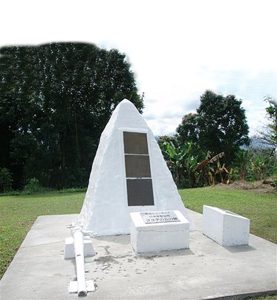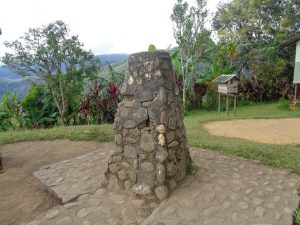Japanese Memorials & Kokoda – Peter Ryan
Unexpectedly there are two Japanese memorials on the Kokoda Track.
The first is that erected in 1979 by the Japanese PNG Goodwill Society with the permission of local authorities after it was agreed that the monument would honour all war dead.
The monument displays the barrel of a Japanese mountain gun used along the Kokoda corridor. This gun was buried during the Japanese retreat and was retrieved in 1966 from the Gorari battle site and obtained by Bert Kienzle’s son ‘Soc’. Initially the gun stood on the lawn at the Kienzle family home in Yodda.
In 1968 a party of Japanese war veterans, widows and other relatives had come to the area to try to retrieve the remains of Japanese soldiers who had died in the campaign. Included in the party was a veteran named Nakahashi. He recognised the gun as that used by First Lieutenant Takaki.
His story:
Major-General Horii decided to commence a general withdrawal from the Oivi area on 10 November 1942. On arrival at Gorari at dawn, we found that due to continuous rain, the Kumusi river was in flood and that crossing the river by the soldiers who were exhausted was very difficult. While preparing to withdraw from Gorari, First Lieutenant Takaki Yoshijo received orders to bury his gun and carry out the wounded from Force HQ. Takaki was a young, commissioned officer of the 53rd intake of the Military Academy and an artillery officer into the bargain – an artilleryman and his gun are one.
He had a firm belief in the artilleryman’s manual and would be unable to bury his gun no matter what. He had entreated the Force Commander that he be permitted to take both the gun and the casualties, but this was refused, so he had no alternative but to return to his company. He called the men together and explained the situation and obtaining their consent, the gun was destroyed and buried. He made his final farewells to all members of the company and then he gave orders to take the wounded to the rear. He then returned to the spot where we had buried the gun and, sitting down, he calmly pulled out his pistol and shot himself in the head.
At that time First Lieutenant Takaki was 24 years old, fiercely patriotic and a fine, upstanding figure of a young officer. His character was such that he was not only popular in his own company but throughout the entire unit. His actions were in accordance with his own beliefs as an officer in the artillery, however, it was regrettable that all this should be wasted in the battlefield. At that time I was the company clerk. I was older but I had lost a friend. During the battles, each time we met, he asked after the dead. I saw him last at Kokoda.
When I saw the barrel of the gun that had been abandoned under such distressing circumstances, I was filled with deep emotion. Remembrances of those times brought about a flood of tears. I, who had had a lifetime of friendship with the officers and men of that unit, had been strangely destined to discover this gun barrel. I must have been guided by the spirit of the First Lieutenant Takaki. Even now I can still see his face and I pray for his happiness in the next world.
The Efogi Memorial
Wording on the Monument (translated)
(Erected December 1979)
This monument has been erected in memory of all the war dead, Japanese, Papua New Guineans, and Australians, in appreciation of their greatest courage during the campaigns in Kokoda, Buna and Giruwa and also to commemorate the landing on July 21, 1942 of the Japanese Nankai Detachment at Gona and its withdrawal from Kumusi on February 7, 1943.
The second monument is at Efogi 2. It is a stone cairn with an engraved top stone, and was built (unsanctioned) by Kokichi Nishimura, (the Bone Man of Kokoda) who spent 26 years in PNG repatriating the bones of his fellow soldiers. The stone cairn still stands; however, the top engraved stone is now held by the local landowner. He will only bring it out upon request (and a small payment).
The top stone was engraved by the monks at Zenshoan Temple in Tokyo—the wording reads ‘To the Loyal War Dead’.





